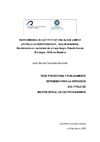Identificador persistente para citar o vincular este elemento:
https://accedacris.ulpgc.es/jspui/handle/10553/75220
| Campo DC | Valor | idioma |
|---|---|---|
| dc.contributor.advisor | Haroun Tabraue, Ricardo Jesús | - |
| dc.contributor.advisor | Pestana Andrade, Carlos A | - |
| dc.contributor.advisor | Diego Castejón Bueno | - |
| dc.contributor.advisor | Andrade, Carlos | - |
| dc.contributor.author | Cañizares González, José Manuel | - |
| dc.date.accessioned | 2020-11-05T10:19:59Z | - |
| dc.date.available | 2020-11-05T10:19:59Z | - |
| dc.date.issued | 2020 | en_US |
| dc.identifier.uri | https://accedacris.ulpgc.es/handle/10553/75220 | - |
| dc.description.abstract | Debido a su interés gastronómico y comercial, las lapas son un producto muy demandado en toda la zona de la Macaronesia, y en concreto en el archipiélago de Madeira. La alta demanda de estos animales ha llevado a la necesidad de la creación de legislación específica para su protección y a la investigación de su cultivo para fines comerciales. Patella candei y Patella aspera son nativas de esta zona. Se han creado protocolos, basados en el estudio de otras especies de lapas (Patella ferruginea y Cellana sp.) y gasterópodos (Haliotis sp.) para la captura y aclimatación de estos animales. Con el objetivo de producir larvas de P. candei se han realizado distintos ensayos para estudiar la maduración artificial de los ovocitos con pH básico (Activación), así como de fecundación in vitro combinando los mejores protocolos de activación con distintos tiempos de fecundación. La mayor producción de larvas se correspondió con una activación a pH 9,5 durante 2,5h y un tiempo de fecundación de 24 h. Adicionalmente, se han realizado experimentos para estudiar la viabilidad de los gametos tras su extracción y para estudiar de forma preliminar la influencia de la temperatura y salinidad sobre la producción larvaria. De esta forma se sienta una base para el cultivo intensivo de estas especies. El desarrollo embrionario y larvario es brevemente descrito. | en_US |
| dc.description.abstract | Due to its gastronomic and commercial interest, limpets are a highly demanded product throughout the Macaronesia area, and specifically in the Madeira archipelago. The high demand for these animals has led to the need of the creation of specific legislation for their protection and to the need of research of their cultivation for commercial purposes. Patella candei and Patella aspera are native to this area. Protocols have been created, based on the study of other limpet species (Patella ferruginea and Cellana sp.) and gastropods (Haliotis sp.) for the collection and acclimatization of these animals. In order to produce P. candei larvae, different tests have been carried out to study the artificial maturation of oocytes with basic pH (Activation), as well as in vitro fertilization, combining the best activation protocols with different fertilization times. The highest larval production corresponded to an activation at pH 9,5 for 2,5h and a fertilization time of 24h. Additionally, experiments have been carried out to study the viability of gametes after their extraction and a preliminarily study of the influence of temperature and salinity on larval production. In this way, a foundation is established for the intensive production of these species. Embryonic and larval development is briefly described. Keywords: Limpets, Madeira, Patella candei, eggs artificial maturation, in vitro fertilization. | en_US |
| dc.language | eng | en_US |
| dc.subject | 251092 Acuicultura marina | en_US |
| dc.subject.other | Limpets | es |
| dc.subject.other | Madeira Island | es |
| dc.subject.other | Patella candei | es |
| dc.subject.other | Eggs artificial maturation | es |
| dc.subject.other | in vitro fertilization. | es |
| dc.title | Performance in captivity of the black limpet (Patella candei d'Orbigny, 1840) in Madeira | en_US |
| dc.title.alternative | Rendimiento en cautividad de la Lapa Negra (Patella Candei D'orbigny, 1840) en Madeira | en_US |
| dc.type | info:eu-repo/semantics/masterThesis | en_US |
| dc.type | MasterThesis | en_US |
| dc.contributor.departamento | Departamento de Biología | en_US |
| dc.contributor.facultad | Facultad de Ciencias del Mar | en_US |
| dc.investigacion | Ciencias | en_US |
| dc.type2 | Trabajo final de máster | en_US |
| dc.description.notas | Máster en cultivos marinos ; 2019-2020. Diploma de Master of Science en Acuicultura otorgado por el Centro Internacional de Altos Estudios Agronómicos Mediterráneos (CIHEAM) | en_US |
| dc.utils.revision | Sí | en_US |
| dc.identifier.matricula | TFT-57271 | es |
| dc.identifier.ulpgc | Sí | en_US |
| dc.contributor.buulpgc | BU-BAS | en_US |
| dc.contributor.titulacion | Máster Universitario en Cultivos Marinos | es |
| item.grantfulltext | restricted | - |
| item.fulltext | Con texto completo | - |
| crisitem.advisor.dept | GIR ECOAQUA: Biodiversidad y Conservación | - |
| crisitem.advisor.dept | IU de Investigación en Acuicultura Sostenible y Ec | - |
| crisitem.advisor.dept | Departamento de Biología | - |
| Colección: | Trabajo final de máster Restringido ULPGC | |
Visitas
182
actualizado el 04-may-2024
Descargas
60
actualizado el 04-may-2024
Google ScholarTM
Verifica
Comparte
Exporta metadatos
Los elementos en ULPGC accedaCRIS están protegidos por derechos de autor con todos los derechos reservados, a menos que se indique lo contrario.
